Now over 40 years old, the AJAC Car of the Year TestFest was held at the Canadian Tire Motorsport Park (Mosport to racing fans) from October 16-18, 2023. Thirty-four members of the Auto Journalists of Canada (AJAC) attended the two-day vehicle testing event; their votes will determine the vehicles that will be chosen as the 2024 Canadian Car of the Year and Truck of the Year.
The reviews that follow cover some of the significant vehicles available to AJAC members at this year’s TestFest.
Toyota Prius Prime
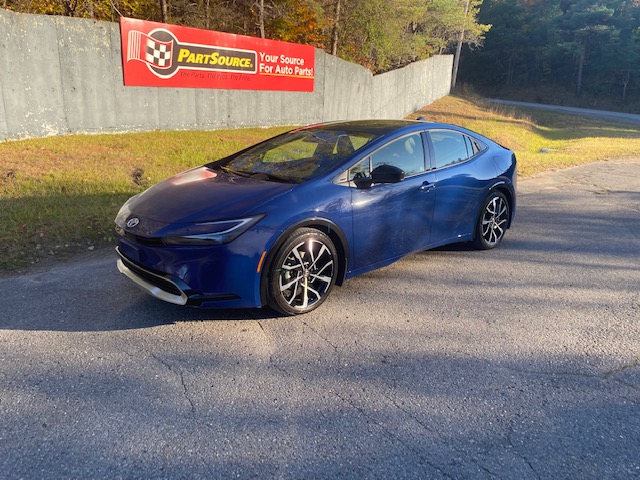
The distinctly odd design of the previous Prius Prime has been replaced by something incredibly sleek
New for 2023, the current-generation version of the PHEV Prius Prime, is a significant upgrade from the model it replaced.
The new Prius is a refreshingly modern design, a big improvement over its visually-challenged predecessor. The cabin is avant-garde, well thought out and easy to live with. Toyota’s latest infotainment controls are not particularly user-friendly. Climate is controlled by convenient buttons and piano keys.
Cabin materials are attractive enough and the cabin aesthetic is one of visual restraint. The front seats are firm and there is plenty of space. The rear seat is comfortable enough and legroom is reasonable for this size of car, but headroom is not abundant. The trunk is long, but, like the car, slightly narrow, with a bit less volume than earlier models. The hatchback body style is versatile.
With 220 total system horsepower, the Prius Prime is quick, but doesn’t feel as quick as that horsepower rating would indicate. The car is serene in full electric mode but when activated, the gas engine is less refined than expected. The transition from electric to gasoline power is smooth. Steering is nicely weighted and precise, handling is crisp and the ride is reasonably compliant. Toyota has really upped its vehicle dynamics game over the last few years and the Prius Prime reflects this new prowess. Visibility is good to the front and sides, but the rear window is small and there is no wiper — that’s a handicap in Canadian winters.
Toyota GR Corolla

GR stands for Gazoo Racing. This is no ordinary Corolla
Though ostensibly in the same “compact supercar” segment as the Honda Civic Type-R, the GR Corolla is a much different car than its rival.
To start, the GR Corolla is built on a 95 mm (3.7 inch) smaller wheelbase, is 186 mm (7.3 inches) shorter, but 74 mm (2.9 inches) taller than the Civic Type-R. The GR’s smaller footprint and higher seating position make it easier to place on the road.
The GR Corolla is powered by a 1.6L three-cylinder turbo that cranks out 300 horsepower and 273 lb-ft of torque. Power flows to all wheels via a six-speed manual transmission. The “frenzied bumble bee” idle of the GR morphs into a rabid wail as the car moves from a stop in first gear, smoothing out to an engaging howl as the engine races for the redline. The GR’s clutch engages in a linear fashion; the gearchange is precise, but it doesn’t have the ultimate precision of the shifter on the Honda Civic Type R. The higher seating position and tidier dimensions of the GR Corolla compared to the Type R make it feel more fun to drive. Except for the very supportive front sport seats and premium faux-suede seat inserts, the cabin is essentially the same as a regular Corolla. Room up front is good, but the shorter wheelbase of the hatchback compared to the Corolla sedan results in rear seat legroom that is more adequate than generous.
Though playing to the same enthusiast market for highly tuned variants of mainstream cars, the Civic Type R and the GR Corolla are very different cars that will appeal to different buyers.
Kia EV9
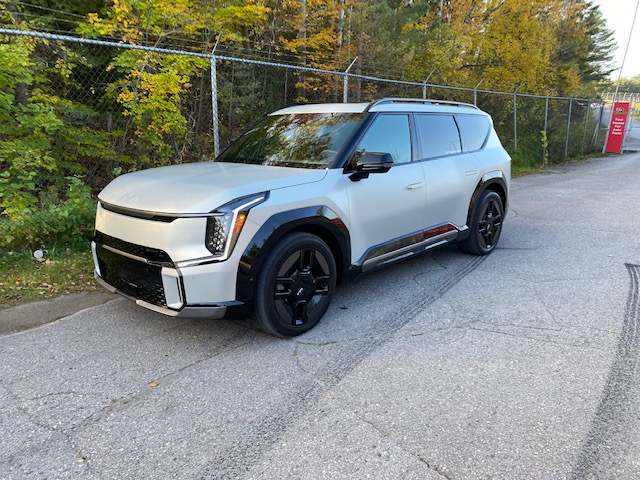
Elegant, fast, quiet and massive. The new Kia EV9
The EV9 is built on a 200 mm (7.9 inch) longer wheelbase than Kia’s gasoline-engine Telluride, but casts a similar shadow on all exterior dimensions, which places the EV9 in the XXL crossover segment.
The EV9 looks fresh, modern and purposeful. The cabin is very elegant, with a blocky, horizontal dashboard. Infotainment functions are touch-sensitive, with physical buttons operating the climate controls. Like the Telluride, cabin and cargo space are substantial.
The only battery pack available initially is rated at 99.8 kWh. The EV9 accelerates with great vigour and in near silence. The ride is absorbent, and handling is sound and predictable, but drivers are conscious of the prodigious weight (up to 5800 pounds) of the vehicle. Braking feels strong and the steering is nicely weighted and holds its line well.
Standard active safety equipment should include forward collision warning, junction turning intervention, autonomous emergency braking, blind spot and rear cross traffic monitors, a lane keep assist system and active cruise control with stop and go. Proposed options include active blind spot intervention and a 360-degree camera.
Hyundai Ioniq 6
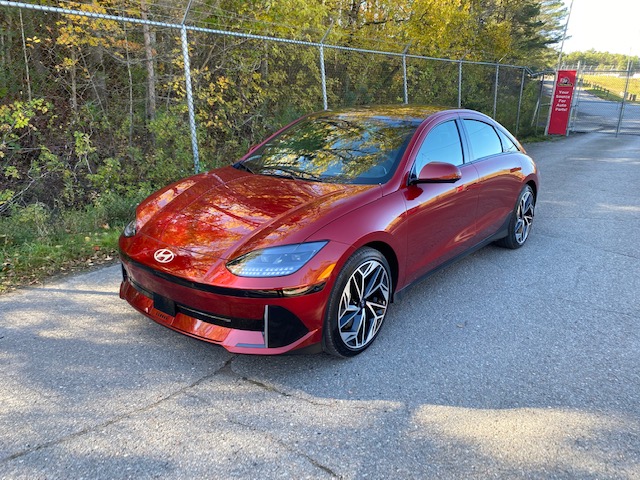
The Ioniq 6 has a very stylish design
The Ioniq 6 is Hyundai’s 4-door tribute to the Porsche 911 (!) With a long wheelbase, short overhangs and a fastback roofline, it is very attractive. With a super low .22 coefficient of drag, it has the longest range of the Hyundai and Kia models that share its EV platform. There is some interesting exterior detailing, including triangular elements that connect the front fascia to the chin spoiler and the repetitive square motif, called “Parametric Pixels” by Hyundai, that adorn the headlights and the taillights of the Ioniq 6.
Inside, the door panels have door pulls incorporated into the door trims, which bear an interesting and unique horizontal rib motif. The proliferation of squares outside is repeated inside with four bright-finished squares embossed into the steering wheel boss. The front seats are roomy and comfortable. The rear seat is supportive and though there is substantial legroom, comfort is somewhat diminished as the low-mounted front seats prevent rear occupants for putting their feet under them. Headroom is more adequate than generous. Trunk space is smaller than usual for this class of vehicle but still adequate; its size is a consequence of the slinky shape of the body.
Driven in dual-motor form, the Ioniq 6, produces 239 kW (320 horsepower) from its 77.4 kWh battery pack. Power is abundant and acceleration is both swift and silent. Steering is nicely weighted and direct and the ride-handling compromise is well-judged for a luxury touring car. Brake pedal feel is good, despite the use of regenerative braking. The Ioniq 6 feels very solid and is very quiet.
Toyota bZ4X
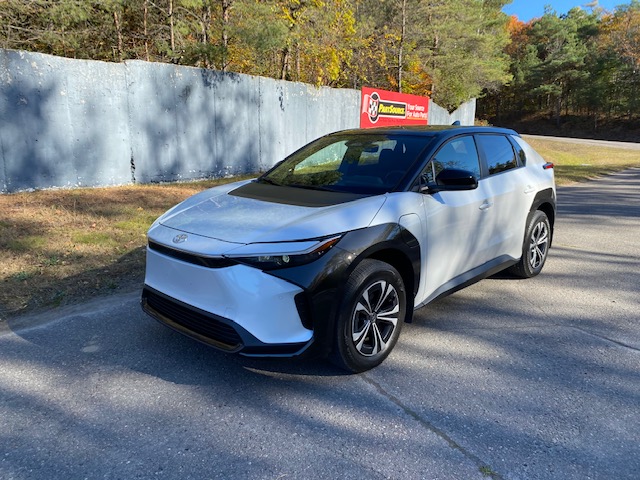
A nice effort, but the bZ4X is essentially a showroom phantom
With delivery delays measured in years, the bZ4X is more of a placeholder for future Toyota EVs than an actual vehicle a consumer can buy. Nonetheless, Toyota did have an example on hand and the APA had a chance to drive it.
Inside, the driver faces a compact and crisply marked gauge pod that is supported by arms on each side that are anchored to the rounded main dash panel. A massive, free-standing screen dominates the centre of the dash. Cabin materials are attractive, with fabric covering the dashboard and the seats. Front seats are comfortable, and room is abundant. The rear seat is supportive and legroom is impressive. There are big front door bins and in and beneath the “flying bridge” front console. At 784 litres with the rear seat up, cargo space is considerably less than the 1059 litres of the conventional RAV4.
The 71.4 kWh battery pack produces a combined 214 horsepower on the dual-motor all-wheel drive variant provided by Toyota for the TestFest. Acceleration is brisk and very quiet. Steering is nicely weighted and geared, the ride is absorbent, and handling is steady. The regenerative brakes work well.
Though not really available, the bZ4X is a worthy enough vehicle for BEV intenders but its very long delivery times makes it more of a promise of what Toyota may do in the future rather than an actual vehicle.
Toyota Grand Highlander
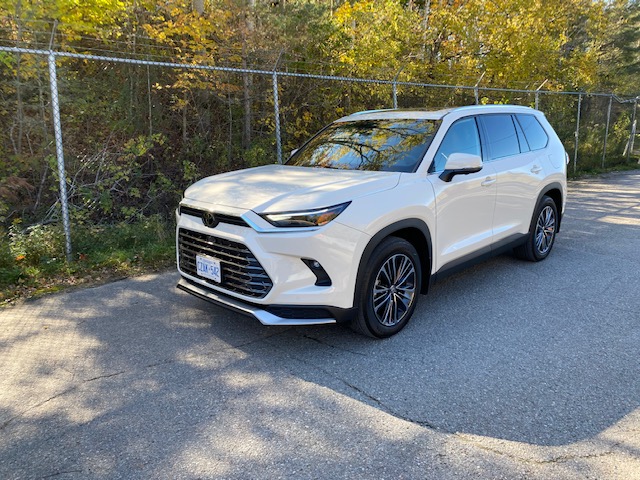
The Grand Highlander is roomy and versatile
Built on Toyota’s versatile TNGA-K architecture, the new Grand Highlander is a substantial 525 mm (20.7 inches) longer, and both wider and taller than the evergreen Highlander. Its dimensions place the Grand Highlander in the XXL crossover category along with vehicles like the Hyundai Palisade, Kia Telluride and the Enclave-Traverse-XT6 triplets from GM. This may signal a realignment of the Toyota crossover lineup which could result in a larger next-generation RAV4 and the elimination of the mainstream Highlander as the automakers continue to upsize their models.
The driver faces a configurable TFT gauge package with much crisper graphics than usually seen in a Toyota. A massive, free-standing infotainment screen dominates the top-centre of the dash. The infotainment screen is equipped with the new Toyota infotainment logic system with a single on-off-volume knob, and a touchscreen menu to the left of the screen. Climate is controlled by a variety of knobs, buttons and toggles that are logical and straightforward. The substantial front seats are comfortable. The middle-row seats are supportive; while legroom is excellent, the seat cannot be moved fore and aft. The third-row seat is reasonably spacious for smaller adults; cargo volume is good with the third-row seat in place; growing to very substantial with the second and third-row seats folded. Cabin materials are attractive.
The Grand Highlander can be powered by a variety of engines seen in other Toyotas. Most common will likely be the same 265 horsepower, 2.4L turbo four found under the hood of the traditional Highlander. The mainstream hybrid model is powered by a 2.5L four and electric motor that is rated at 247 horsepower, which may be a bit light for such a massive vehicle. Power reaches the front wheels via a CVT with the rear wheels driven electrically. The Hybrid Max combines the efforts of a turbocharged, 2.4L gas engine and the hybrid system to create a stout 362 horsepower. All-wheel drive is standard.
The Hybrid Max powertrain delivers vivid acceleration accompanied by a discreet wail that echoes the soundtrack of a traditional Detroit V8. Bizarre. The transmission works without drawing attention to itself and the Grand Highlander drives in a way that will please its intended market. Though it is a very nice vehicle, the Grand Highlander, like other XXL crossovers, may have grown too large to be a practical daily driver in urban-suburban environments.
Subaru Impreza

Though all new, the Impreza doesn’t look much different from its predecessor
Though all new, the styling changes made to the 2024 Impreza are very subtle and will go unnoticed by most observers. The new Impreza uses the dashboard that debuted in the most-recent iteration of the WRX sport sedan. The driver faces a conventional speedometer and tachometer with a configurable digital readout separating them. The previous multi-configurable “Eyebrow” feature at the top centre of the dash has been excised with all information now incorporated in a large, vertically oriented touch screen. Subaru wisely retained knobs for audio on-off-volume and tuning, as well as physical buttons for front and rear defrost and temperature regulation for the dual-zone climate system. Climate fan speed and air distribution are adjusted via the touch screen but are sequestered within a menu system and visible on the screen at all times. The front seats, previously a bit unyielding, are now more padded. Like the previous Crosstrek, cabin space is impressive for the size of the vehicles and large adults can contemplate a long journey in the rear seat without fear.
The RS model is powered by a 2.5L, normally aspirated flat-four with 182 horsepower. Torque is delivered to all four wheels via a CVT which is the sole transmission offered for 2024. Performance is strong and flexible, and additional soundproofing has enhanced mechanical refinement. Road and wind noise are also reduced.
Steering is nicely weighted and geared and is less vague at highway speeds than it was in the previous Impreza. Handling is sound and the ride is compliant. The Crosstrek has been a big success for Subaru, with high resale values and consistently strong demand; the new model will likely continue the tradition.
Hyundai Kona
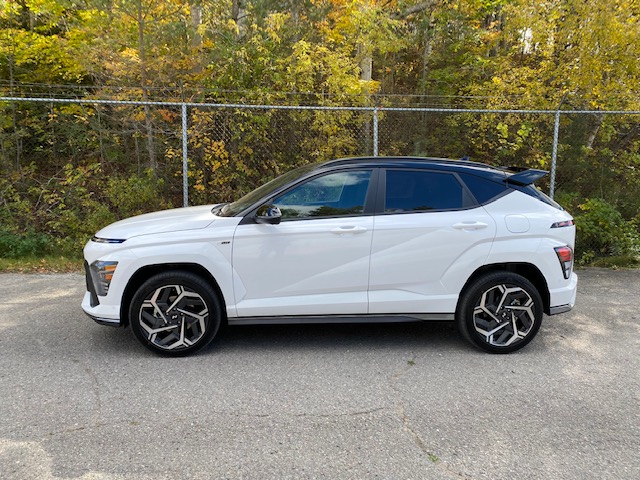
Just because there are a plethora of lines to chose from doesn’t mean you have to use all of them at the same time
After six years on the market, Hyundai has renewed its very successful Kona. The second-generation Kona has been stretched significantly and is 145 mm (5.7 inches) longer than before and marginally wider. This growth rectifies two limitations of the original Kona, which were tight rear seat legroom and limited cargo space. However, previous Kona owners may miss the urban-friendly footprint of the original.
The side profile is polarizing. The side silhouette echoes that of the old Kona, but the addition of the impressed “Z” motif first seen on the Ioniq 5 BEV, renders the car visually incoherent. With the Tucson, Elantra and now the Kona, Hyundai took big styling risks which have paid off handsomely.
Hyundai and Kia are masters at straightforward minor controls, with simple knobs and buttons to manipulate climate and audio functions. Like the Ioniq 5, the dashboard of the new Kona reflects angular, 1980s design conventions. Despite the elevated price of the N-Line model driven, there are large amounts of hard plastic trim inside the car. The vinyl and faux suede seats of the N-Line model are very attractive. Front seats are comfortable, the driving position is very good and room is plentiful. There are a lot of storage spaces in the car, including a massive bin in the centre console. The rear seat is supportive, and legroom is much improved compared to the previous Kona. Limited cargo space, a shortcoming of the last Kona, has been addressed with the new one.
Two conventional engines, a 147 horsepower 2L four and a turbocharged 1.6L four with 190 horsepower, return for 2024. The Kona N-Line available at TestFest was powered by the 1.6L turbo hooked up to a conventional eight-speed automatic transmission. Performance is brisk, linear and flexible. Steering is quick and precise, and the ride and handling balance of the car is very well judged.
The Kona is closely related to the Kia Seltos, which is better looking than the Kona and is also smoother and a bit quieter.
Honda Civic Type R

Astounding performance and civility combine to create the Civic Type R
The Type R of the Civic builds upon the positive attributes of the Civic and adds spectacular, useable performance.
The Type-R’s cabin adds some sporting touches to the already luxurious cabin of the current Civic, including grippy, but not confining front sport seats and red faux suede front seats and carpets. Like some other Honda-Acura models, the front and rear seats are treated as completely different zones, with the front seats swathed in plush red faux suede but the rear seat is covered in an underwhelming black cloth. The interior is roomy front and rear and the hatchback cargo bay is commodious.
With 315 horsepower, the term “Civilized Hooliganism” is an apt description of the Type R. The turbocharged 2L four is impressively serene in gentle driving but when full performance is requested, the zingy, rev-happy engine takes on a feral bellow that is sonically compelling. The engine sends power to the wheels via a docile clutch and gears are selected by a manual transmission with a precise, snicky, mechanical-feeling action. Despite the massive power going through the front wheels, torque-steer is not an issue but there is some ‘tramlining” effect on road imperfections due to the super-wide tires. Steering is precise and transmits road surface information to the driver very well. Handling and grip are impressive and the ride is resilient, especially considering the phenomenal handling of the Type R.
